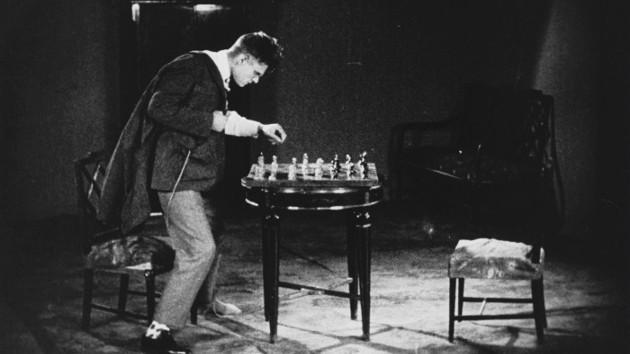There seems to be an inherent fascination with chess in cinema. Films from a wide range of genres and countries use the game as an allegory, as a metaphor, for the battles within and sometimes the battlefield itself. Chess scenes are often used to showcase any given character’s intelligence as well as the dynamic between two characters on opposing sides of a given film’s central conflict.
But is there such a thing as a good or bad chess scene? Chess players would say so. With pieces in the wrong places, movements that don’t exist, and even the chess board being placed wrong, mistakes are at every corner when it comes to depicting the game on the big screen. Here are ten of the best chess scenes in movies: both accurate to the game of chess and important to the plot of each of these films.
The Seventh Seal (1957)

The most famous chess scene in cinema history is in The Seventh Seal, which has influenced various other media that represent Death as a man with a dark cape playing chess with mortals. The film is also one of the most famous movies in the history of cinema, as it is widely considered a masterpiece and one of Ingmar Bergman’s best works. Set during the Black Death in Sweden, The Seventh Seal shows a disillusioned medieval knight Antonius Block (Max von Sydow) playing chess against Death (Bengt Ekerot) who has come to take his life.
The game of chess deceives the man into thinking he can control his own life and that he can keep death at bay by keeping the game going, as the Knight is the one who challenges Death to a chess match. This may also suggest a commentary on mankind’s desire and illusion to escape – or even best – death.
According to director Ingmar Bergman, the image of a man playing chess with Death was inspired by a medieval painting by Albertus Pictor from the 1480s. Other aspects of the film have been inspired by medieval art, but this scene resonated with audiences worldwide. The image of Death playing chess is still present in our cultural imagery today.
Blade Runner (1982)

Roy (Rutger Hauer), a replicant seeking to extend its limited lifespan, attempts to beat his maker, Tyrell (Joe Turkel), the CEO of the Tyrell Corporation, at a chess game to gain access to Tyrell’s penthouse. This scene is used to deliver a commentary on the relationship between the characters involved but also encourages us to think of the creator versus creation dynamic, a theme central to cyborg/artificial intelligence philosophy.
In this scene, Roy uses the winning combination from an 1851 game called the “Immortal Game” which involves sacrificing three pieces. Interestingly, this mirrors the events in the film when Roy sacrifices three friends to get to his encounter with his God. On the board, the sacrifice pays off. Roy wins the game and thus manages to speak to Tyrell, but his meeting with Tyrell does not go exactly as he may have hoped.
2001: A Space Odyssey (1968)

2001: A Space Odyssey uses chess to reflect on the relationship between man and machine, and to signify the unequal dynamics of the two characters playing it. Director Stanley Kubrick was an avid chess player, which might be part of why the game features so prominently in one of the beginning sequences of the film. Astronaut Frank Poole (Gary Lockwood) plays chess against the artificial intelligence HAL 9000 (Douglas Rain). This sets up the futuristic look of the film and the high level of technology in the story as Frank is playing chess against a supercomputer using a video screen.
This scene also sets up HAL as a character, introducing us to how the artificial intelligence engages. In the simple case of presenting chess, the dialogue signposts the audience by having the characters narrate their every move. In the wider case of the film, Frank struggles to figure out what his next move should be and eventually resigns, perhaps signaling that the human being isn’t as in charge as he thinks he is.
Harry Potter and the Philosopher’s Stone (2001)

Harry Potter and the Philosopher’s Stone features wizard chess, a version of chess where the pieces are destroyed rather than taken. The game reflects the uniquely magical atmosphere of the wizarding world but also very much serves the plot, at least in the first installment of the series.
At the end of the first film, Harry (Daniel Radcliffe), Ron (Rupert Grint), and Hermione (Emma Watson) take the place of three pieces on the board to reach the philosopher’s stone. To create a realistic and high-stakes game, the production hired Jeremy Silman, a US Chess master, to create an eight-move endgame in this sequence. We see clear moves on the board and the Scandinavian Defense, a famous chess opening, at the beginning of the sequence. This exposes Harry Potter’s younger audiences to the severity of the magic at play and to Harry’s own story without necessarily frightening children.
Casablanca (1942)

Casablanca star Humphrey Bogart loved chess and played it in several movies. In fact, he was the one who requested that his character, Rick Blaine, play chess in this iconic Golden Era Hollywood movie. In his very first appearance in Casablanca, Bogart’s character Rick is sitting at the chessboard in his café, a meeting place for soldiers and fugitives in 1942 Morocco. The game itself may not be essential to the narrative – even in the scene where chess is featured, the narrative and dialogue of the film focus on something else entirely – but it is a great introduction for the enigmatic main character.
The scene gives us an insider look into how Rick positions himself in the world: by himself, using logic to solve his problems. This moment acts as foreshadowing, as the position that Rick analyses on the board has emerged from a French Defence, thus forcing him to side with the French in chess as he will in life later on.
Chess Fever (1925)

Chess Fever is a Russian silent comedy about the 1925 chess tournament in Moscow. The film is Vsevolod Pudovkin’s directorial debut which he co-directed with Mykola Shpykovskyi, who also wrote the movie. The film influenced Nabokov’s novel The Luzhin Defence, published in 1930, as the love story combined with chess is essential to both works. While some of the film is presented through acted drama, it uses actual footage from the real tournament in a documentary-like fashion. As such, the film also includes various cameos from chess champions and grandmasters who participated in the tournament.
The game also creates significant issues between the main couple, the hero (Vladimir Fogel) and the heroine (Anna Zemtsova). The hero starts forgetting his marital obligations once he gets caught up in chess, which he is seen playing multiple times. Throughout the film, he is constantly pulled between his marriage and his passion for chess, but can the two ever reconcile in his life?
Queen to Play (2009)

Based on a novel called La Joueuse d’échecs by Bertina Henrichs, Queen to Play is a French-German film set in Corsica. The film follows Héléne (Sandrine Bonnaire), a French chambermaid who develops an interest in chess. While cleaning the house of Kröger (Kevin Kline), an American doctor, he helps her practice chess and improve as the two start playing together.
Chess allows Héléne to assert herself in her private life and her job, but the film also shows us how passionate she is about the game. Even for those in the audience who may not be familiar with the game, the film does a good job of portraying how chess becomes an obsession for some people.
From Russia with Love (1963)

From Russia with Love opens with a chess match at the Venice International Grandmaster Championship in the final match between Kronsteen (Vladek Sheybal), a Russian agent, and McAdams (Peter Madden). As part of the James Bond series, the movie follows James Bond (Sean Connery) as he is sent to Turkey to assist in the defection of Tatiana Romanova (Daniela Binachi), a Soviet consulate clerk who will soon become his love interest. There, the international criminal organization SPECTRE, whose chief planner is the Czechoslovak chess grandmaster Kronsteen, plans to take revenge against Bond for the death of one of their agents in Jamaica.
The Venice International Grandmaster Championship is, of course, not a real tournament, but the set-up of the board is believable. The scene creates significant tension as the crowd within the film and the film’s audience wait to see who will win the game. The positions are visible on the big demonstration board behind the characters in order to show the game to the larger public. It is also extremely useful in the film, as it allows for a dynamic camera set-up. The film does not rely exclusively on the board in front of the players but also focuses on more unique shots including the big board.
Searching for Bobby Fischer (1993)

Based on the real-life story of Joshua Waitzkin, a prodigy chess player, and adapted from a book of the same name, Searching for Bobby Fischer is one of the most famous and well-made films about chess. The film was received positively by critics, chess enthusiasts, and general moviegoers who may not know or care much about the game. The movie was also nominated for Best Cinematography at the Academy Awards in 1993 and is featured in the American Film Institute’s list of most inspiring films.
The film follows seven-year-old Josh Waitzkin (Max Pomeranc) as he becomes fascinated with chess by watching players in Washington Square Park in New York City. Despite her initial concerns due to the illegal gambling and homeless players in the area, his mother Bonnie (Joan Allen) eventually allows him to play one game and is surprised to see that, while Josh may have lost, he seems to understand the rules of chess very well despite never having been taught. Not only is the game portrayed well, but it delivers an important explanation of chess moves and theory as Josh learns the basics of the game. It also shows his intuition and inherent talent for the game as those around him try to control his career for their own interests and benefit.
The Luzhin Defence (2000)

The Luzhin Defence follows Aleksandr Ivanovich Luzhin (John Turturro), a gifted but tormented chess player as he arrives to compete in a world-class tournament in Italy. In the 1920s, Luzhin meets Natalia Katkov (Emily Watson) and immediately falls in love with her before arriving for the tournament where other chess players believe that he won’t be able to handle the pressure of the competition. The tournament does not go too well for Luzhin as he is unsettled by seeing his former friend, the Russian Leo Valentinov (Stuart Wilson), who was also his former chess coach.
In this film, chess becomes a way for Luzhin to prove himself against those around him who doubt his capabilities. The game is also his addiction that he seems to never free himself from. In one of the final chess scenes, Luzhin plays against Salvatore Turati (Fabio Sartor). How they move the pieces is not entirely accurate, but it is interesting to see Luzhin run through all the possible scenarios in his head, which is visualized on the board for viewers to see.
List Courtesy of Clotilde Chinnici
Feature Image from ‘The Seventh Seal’ via Bardavon

Recent Comments